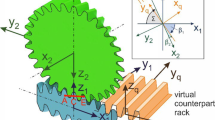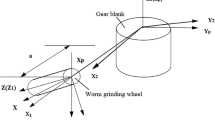Abstract
Longitudinal-crowned involute helical gears perform better in load capacity and can improve transmission quality. When longitudinal crowning of helical gears is processed with continuous generating grinding, the flank twist occurs and reduces the transmission stability of gears. In the paper, an innovative approximation model is proposed to demonstrate the relationships between the flank twist and parameters (including gear parameters and modification parameters) in a simple mathematical form. The flank twist calculated by the approximation model is compared with that calculated based on the gear meshing principle. The comparison results confirm that the model is right. Based on the new model, the influences of gear parameters on the flank twist are analyzed. The model can reduce the flank twist in the gear design.







Similar content being viewed by others
Availability of data and material
The data in the paper are just the results from the following program in the next section. The parameters of the gears used in the program are listed in Section 5.1.
Code availability
The software is complex, so the main part of the software for calculating the flank with flank twist is provided below.














References
Karpuschewski B, Knoche HJ, Hipke M (2008) Gear finishing by abrasive processes. CIRP Ann Manuf Technol 57:621–640. https://doi.org/10.1016/j.cirp.2008.09.002
Shih YP, Chen SD (2012) Free-form flank correction in helical gear grinding using a five-axis computer numerical control gear profile grinding machine. J Manuf Sci Eng 134:041006-1–041006-13. https://doi.org/10.1115/1.4006096
Miller B (2014) Topological gear grinding methods. Gear Solut 5:47–54
Yu B, Shi ZY, Lin JC (2017) Topology modification method based on external tooth-skipped gear honing. Int J Adv Manuf Technol 92:4561–4570. https://doi.org/10.1007/s00170-017-0463-2
He K, Li GL, Li XG (2017) The second envelope method of pointvector and its application on worm wheel grinding modified gear. Int J Adv Manuf Technol 88(9):3175–3184. https://doi.org/10.1007/s00170-016-9028-z
Hsu RH, Fong ZH (2011) Novel variable-tooth-thickness hob for longitudinal crowning in the gear-hobbing process. Mech Mach Theory 46:1084–1096. https://doi.org/10.1016/j.mechmachtheory.2011.03.007
Zhang H, Fang CG, Huang XD (2014) Accurate tooth lead crowning without twist in cylindrical helical gear grinding. Adv Mech Eng 6:1–9. https://doi.org/10.1155/2014/496181
Fong ZH, Chen GH (2016) Gear flank modification using a variable lead grinding worm method on a computer numerical control gear grinding machine. J Mech Des 138:083302-1–083302-10. https://doi.org/10.1115/1.4033919
Hsu RH, Wu YR, Tran VT (2018) Manufacturing helical gears with double-crowning and twist-free tooth flanks using a variable pressure angle shaving cutter. Proc Inst Mech Eng B J Eng Manuf 233:77–86. https://doi.org/10.1177/0954405417718590
Tran VQ, Wu YR (2017) Dual lead-crowning for helical gears with anti-twist tooth flanks on the internal gear honing machine. IOP Conf Ser Mater Sci Eng 282:012005. https://doi.org/10.1088/1757-899X/282/1/012005
Stadtfeld H (1999) Threaded grinding wheel and method of dressing. PCT/US99/06153
ISO 21771 (2007) Gears—cylindrical involute gears and gear pairs—concepts and geometry
Tran VT, Hsu RH, Tsay CB (2014) Study on the anti-twist helical gear tooth flank with longitudinal tooth crowning. J Mech Des 136:061007-1–061007-10. https://doi.org/10.1115/1.4027166
Litvin FL (1994) Gear geometry and applied theory. PTR Prentice Hall, Eaglewood Cliffs
Acknowledgements
The authors would like to thank Christof Gorgels from Klingelnberg for their active support in the preparation of this paper.
Funding
This work was funded by National Natural Science Foundation of China (51805011 and 51635001).
Author information
Authors and Affiliations
Contributions
Bo Yu proposed the new approximation model and verified the model.
Hanlin Kou calculated the flank twist based on the meshing principle.
Baoya Zhao established the meshing coordinate system.
Zhaoyao Shi found that the path of the contact points was a straight line.
Yanqian Sun compiled some figures.
Guoqing Wu provided the parameters of the gears.
Corresponding author
Ethics declarations
Ethics approval and consent to participate
Not applicable.
Consent for publication
Not applicable.
Conflict of interest
Not applicable.
Additional information
Publisher’s note
Springer Nature remains neutral with regard to jurisdictional claims in published maps and institutional affiliations.
Rights and permissions
About this article
Cite this article
Yu, B., Kou, H., Zhao, B. et al. Approximation model for longitudinal-crowned involute helical gears with flank twist in continuous generating grinding. Int J Adv Manuf Technol 114, 3675–3694 (2021). https://doi.org/10.1007/s00170-021-07099-y
Received:
Accepted:
Published:
Issue Date:
DOI: https://doi.org/10.1007/s00170-021-07099-y




